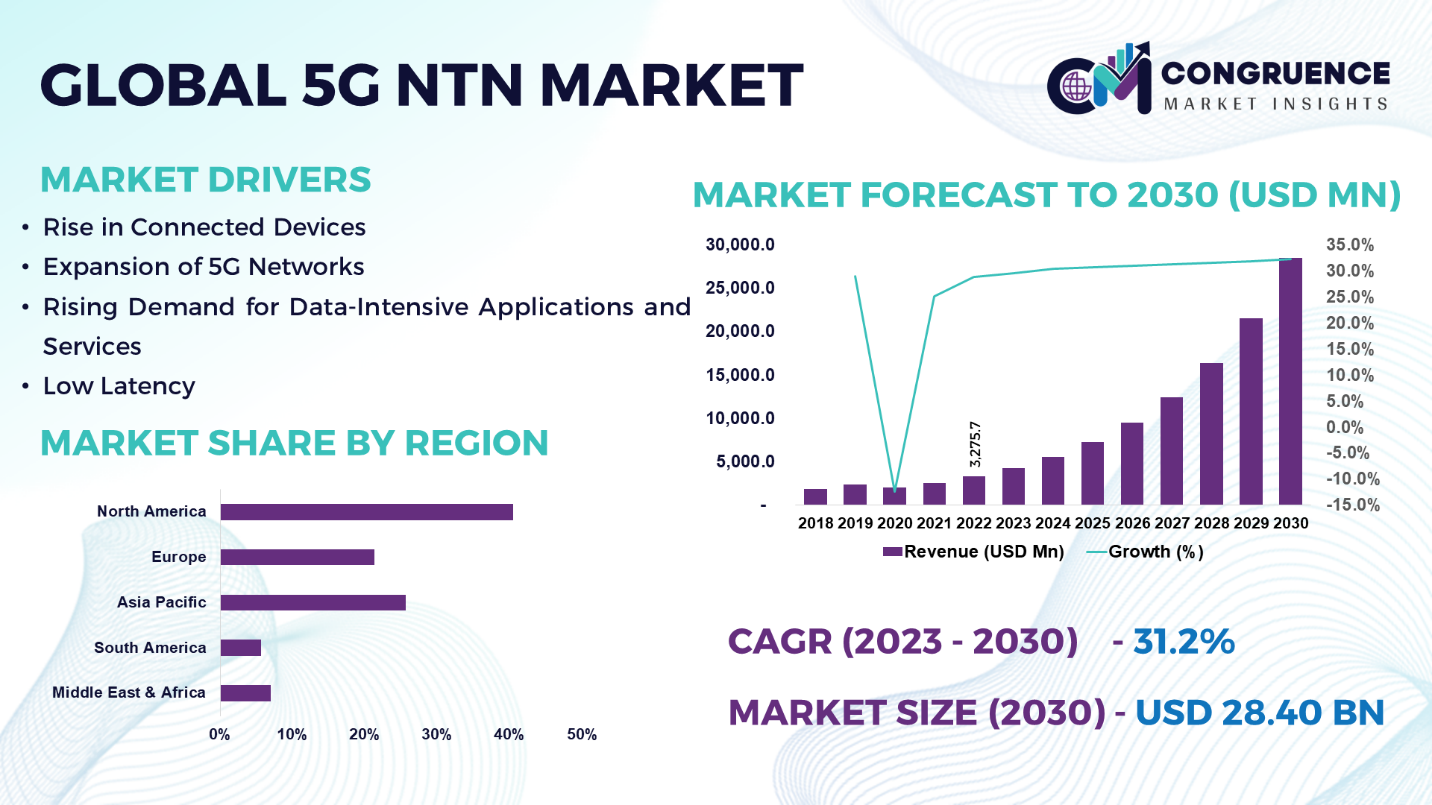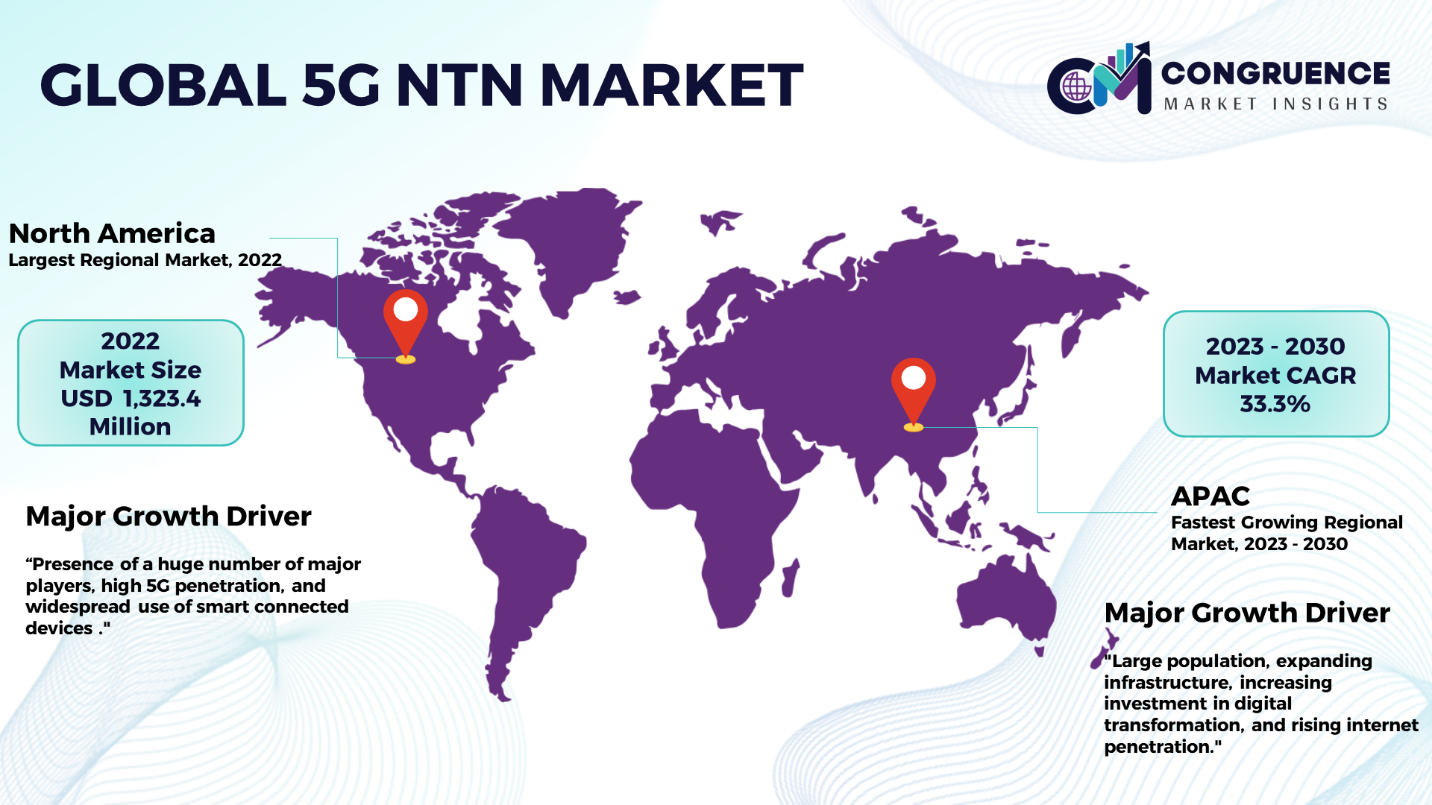Reports
The Global 5G NTN Market was valued at USD 3,275.7 Million in 2022 and is anticipated to reach a value of USD 28,401.5 Million by 2030 expanding at a CAGR of 31.2% between 2023 and 2030.
A 5G NTN (Non Terrestrial Networks) is a satellite based deployments phase of 5G wireless technology used to provide high-speed internet access and data transmission. 5G NTN uses satellite or high-altitude platforms such as drones or balloons to provide users with 5G wireless connections. These networks are designed to support the increasing demand for data-intensive applications and services. The 5G NTN is developed to address the challenges of providing connectivity in remote or rural communities where traditional terrestrial networks cannot reach. It can be classified based on components, location, platform, and applications. Based on component, it is classified into hardware, solutions and services that support the 5G NTN communication. By application, it is divided into near enhanced mobile broadband (EMBB), ultra-reliable and low latency communications (URLCC), and massive machine-type communications (MMTC). The market is influenced by factors such as rise in connected devices, expansion of 5g networks, rising demand for data-intensive applications and services, and low latency. The 5G NTN technology offers several benefits including global coverage, enhanced capacity, low latency, high-speed internet access and data transmission, and improved performance. Global 5G NTN market serves maritime, aerospace and defense, government, mining, and other different industries.

5G NTN Market Major Driving Forces
Rise in Connected Devices: The increasing number of connected devices is having a significant impact on global 5G NTN market. The increasing applications of connected devices including wearables, industrial sensors, and autonomous vehicles creates a huge demand for high speed internet access.
Expansion of 5G Networks: The rapid expansion of 5G networks has been a major trend globally, driving the growth of the 5G market. Telecommunications companies and governments are investing heavily in 5G infrastructure and rolling out new 5G-enabled based devices.
Rising Demand for Data-Intensive Applications and Services: The growth in demand for data-intensive applications and services are driving the need for faster and more reliable wireless networks. The 5G NTN is designed to support the growing demand for data-intensive applications and services, such as virtual and augmented reality, connected devices, and the Internet of Things (IoT).
Low Latency: One of the major advantage of 5G technology is its low latency, which refers to the propagation delay in data transmission. This latency can impact real-time applications that require quick response, such as autonomous vehicles, remote healthcare, interactive games, and. remote-control systems.
5G NTN Market Key Opportunities
Internet of Things (IoT) Connectivity: 5G NTN utilizes satellites and high-altitude platforms to facilitates internet access in remote areas. It has ability to handle a large volume of connections at high speeds, which is crucial for the growth of IoT applications across various industries, including smart cities, connected logistics, remote infrastructure management, and industrial IoT.
Remote Healthcare: Telemedicine and remote healthcare services is becoming more accessible and efficient with low latency and wider coverage, improving healthcare access in remote areas. The high speed connectivity and low latency contribute to real-time communication between healthcare providers and patients, enhancing the access to medical services.
Development of 5G and 6G: With the development of 5G and 6G, the demand for NTN is growing, which is expected to create a significant opportunity for the 5G NTN market. NTN can facilitate extended coverage and connectivity in areas where terrestrial infrastructure is limited or non-existent. Additionally, the integration of NTN into 5G and 6G networks has the potential to enhance their capabilities.
5G NTN Market Key Trends
· The integration of satellite with 5G networking system is an emerging market trend that has great potential to deliver enhanced mobile experiences
· The rapid expansion of 5G NTN market is driven by the development of 5G networks owing to increasing demand for high-speed connectivity
· 5G NTN utilizes satellites and high-altitude platforms to provide internet access in remote areas
· Advancement in edge computing for the improved network efficiency, reducing latency, and enhanced security
· The rise in need for internet of things (IoT) applications and services, such as connected homes, autonomous vehicles, industrial automation and systems drives the demand for 5G connectivity
· Increased focus on security and privacy concerns for addressing challenges related to data transmission is a significant trend
· Implementing hybrid network strategies, combining terrestrial and NTN technologies for a smooth transition and optimal coverage
Region-wise Market Insights
North America accounted for the largest market share at 40.4% in 2022 whereas, Asia Pacific is expected to register the fastest growth, expanding at a CAGR of 33.3% between 2023 and 2030.

North America accounted for the largest revenue share in 2022, due to the presence of a huge number of major players, high 5G penetration, and widespread use of smart connected devices in the region. Moreover, in North America, the demand is driven by the increasing investments in 5G IoT devices, growing deployments of 5G IoT solutions, and the expansion of 5G infrastructure. Europe focuses on providing internet access to remote areas, rising 5G deployment, and increasing collaboration for deploying smart solutions across the region. In Asia-Pacific, the market is characterized by large population, expanding infrastructure, increasing investment in digital transformation, and rising internet penetration which has created an increasing demand for 5G NTN. Furthermore, growing consumer base for high-speed internet, increasing count of satellite launches, and technological advancement is expected to drives the market growth in forecast period. The Middle East and Africa has been witnessing a significant demand for 5G NTN due to the growing focus on providing connectivity to rural communities, and government initiatives for the adoption of 5G NTN technology.
Market Competition Landscape
The global 5G NTN market is heating up on the basis of product quality offered by major players. Major companies operating in the 5G NTN market focus on expanding their business, manufacturing facilities, research and development investments, infrastructural development, and leverage integration opportunities. Key players in the 5G NTN market engage in different strategies aimed at gaining a competitive edge. These strategies include product innovation, collaborations, expansion, innovative products & technologies, reduce production costs, and mergers and acquisitions to meet evolving consumer preferences. Furthermore, these companies establish business strategic partnerships with the global mobile network operators, and leverage MNOs’ terrestrial spectrum to deliver their services. Established brands leverage their reputation for quality and reliability to maintain market share, while newer entrants focus on disruptive innovations and unique selling propositions.
Key players in the global 5G NTN market implement various organic and inorganic strategies to strengthen and improve their market positioning. Prominent players in the market include:
· Qualcomm Technologies, Inc.
· SoftBank Group Corporation
· Thales Group
· Rohde & Schwarz GmbH & Co KG
· Keysight Technologies, Inc.
· MediaTek Inc.
· SES S.A
· EchoStar Corporation
· GateHouse SatCom A/S
· Gilat Satellite Networks
· SpaceX
· AST & Science, LLC
· OneWeb Ltd.
· ZTE Corporation
· Omnispace, LLC
|
Report Attribute/Metric |
Details |
|
Market Revenue in 2022 |
USD 3,275.7 Million |
|
Market Revenue in 2030 |
USD 28,401.5 Million |
|
CAGR (2023 – 2030) |
31.2% |
|
Base Year |
2022 |
|
Forecast Period |
2023 – 2030 |
|
Historical Data |
2018 to 2022 |
|
Forecast Unit |
Value (US$ Mn) |
|
Key Report Deliverable |
Revenue Forecast, Growth Trends, Market Dynamics, Segmental Overview, Regional and Country-wise Analysis, Competition Landscape |
|
Segments Covered |
· By Component (Hardware, Solutions, and Services) · By Platform (LEO Satellite, GEO Satellite, MEO Satellite, UAS Platform) · By Location (Urban, Rural, Remote, Isolated) · By End User (Maritime, Aerospace & Defense, Government, Mining, and Others) · By Application (Enhanced Mobile Broadband(EMBB), Ultra-Reliable Low-Latency Communication(URLLC), Massive Machine-Type Communication(MMTC)) |
|
Geographies Covered |
North America: U.S., Canada and Mexico Europe: Germany, France, U.K., Italy, Spain, and Rest of Europe Asia Pacific: China, India, Japan, South Korea, Southeast Asia, and Rest of Asia Pacific South America: Brazil, Argentina, and Rest of Latin America Middle East & Africa: GCC Countries, South Africa, and Rest of Middle East & Africa |
|
Key Players Analyzed |
Qualcomm Technologies, Inc., SoftBank Group Corporation, Thales Group, Rohde & Schwarz GmbH & Co KG, Keysight Technologies, Inc., MediaTek Inc., SES S.A, EchoStar Corporation, GateHouse SatCom A/S, Gilat Satellite Networks, SpaceX., AST & Science, LLC, OneWeb Ltd., ZTE Corporation, and Omnispace, LLC |
|
Customization & Pricing |
Available on Request (10% Customization is Free) |
